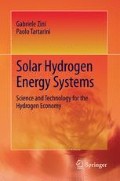Abstract
Although hydrogen is one of the most commonly-found elements in the universe, it rarely exists as an independent molecule on our planet. Most of the time, it is bound to other elements or molecules to form compounds like water, carbohydrates, hydrocarbons and DNA acids. Obtaining hydrogen is not easy and usually requires a certain amount of energy to break the bonds connecting hydrogen to other elements. One process is water electrolysis in which electric energy is used to split water into hydrogen and oxygen. To regain the potential chemical energy stored in the hydrogen molecule, hydrogen and oxygen are combined to yield energy and water in the fuel cell which works in the reaction opposite to the electrolysis. This chapter discusses these two processes occurring in the electrolyser and in the fuel cell, two fundamental components of the solar hydrogen energy system.
Access this chapter
Tax calculation will be finalised at checkout
Purchases are for personal use only
Notes
- 1.
The term production is not intended in the sense that hydrogen is created, but only that hydrogen is obtained in its simplest form (atomic or molecular) by processes that separate hydrogen from other compounds in which hydrogen is one of the constituents. The term will be anyhow used during the course of the book just as in common industrial practices.
- 2.
In chemistry, the equivalent weight (or equivalent mass) is defined as the quantity of mass of a substance able to supply or consume one mole of electrons in a redox reaction, or to generate one mole of H+ ions by dissociation or one mole of OH- ions in an acid—base reaction. It is calculated as the ratio between the molecular weight of the substance (expressed as g/mol) and its number of moles participating in the reaction. A mole is the quantity of a substance that contains the same amount of elementary entities as the number of atoms present in 12 g of C12. Such number is known as the Avogadro’s number, equal to 6.022 × 1023.
- 3.
Standard conditions refer to a pressure of 0.1 MPa and a temperature at 25 °C. For a chemical element, the standard state is the condition it assumes at standard pressure and temperature.
- 4.
While the internal energy is an exact differential because it depends only on the initial and final states, Q and W are not state functions, therefore their integral depends on the cycle. For this reason the symbol δ is used instead of d to indicate that it is not about the exact differentials but rather the infinitesimal quantities of heat and work.
- 5.
The Fick’s first law states that the flux of molecules in a fluid occurs from high-concentration areas to low-concentration regions. The diffusive flux J is given by: J =−D∇φ, where D is the diffusion coefficient that depends on the size of the diffusing molecules, the temperature and the fluid viscosity, while ϕ is the spatial concentration of the molecules. The Fick’s second law gives the change in time of the concentration when the molecules diffuse in a fluid as \( \frac{\partial \phi }{\partial t}=D{\nabla}^2\phi \)
- 6.
The SHE absolute potential is estimated with a Born-Haber cycle to be 4.44 ± 0.02 V at 298.15 K.
References
Aylward G, Findlay T (1994) SI Chemical Data, 3rd ed. Wiley and Sons, New York
Costamagna P, Selimovic A, Del Borghi M, Agnew G (2004) Electrochemical model of the integrated planar solid oxide fuel cell (IP-SOFC). Chemical Engineering Journal 102:61–69
Incropera F P, DeWitt D P (1990) Fundamentals of Heat and Mass Transfer, 3rd ed. John Wiley & Sons, New York
Kordesch K, Simader G (1996) Fuel cells and their applications, 3rd ed. VCH Publisher Inc., Cambridge
Kothari R, Buddhi D, Sawhney R L (2005) Study of the effect of temperature of the electrolytes on the rate of production of hydrogen. Int. J. Hydrogen Energy 30:251–263
Leroy R L, Stuart A K (1978) Unipolar water electrolyzers. A competitive technology. Proc. 2nd WEHC, Zürich, Switzerland, pp. 359–375
Roušsar I (1989) Fundamentals of electrochemical reactors. In: Ismail M I (ed.) Electrochemicals reactors: their science and technology, Part A. Elsevier Science, Amsterdam
Ulleberg Ø (2003) Modeling of advanced electrolyzers: a system simulation approach. Int. J. Hydrogen Energy 28:21–33
Williams M C, Strakey J P, Singhal S C (2004) U.S. distributed generation fuel cell program. J. Power Sources 131:79–85
Author information
Authors and Affiliations
Rights and permissions
Copyright information
© 2012 Springer-Verlag Italia
About this chapter
Cite this chapter
Zini, G., Tartarini, P. (2012). Electrolysis and Fuel Cells. In: Solar Hydrogen Energy Systems. Springer, Milano. https://doi.org/10.1007/978-88-470-1998-0_3
Download citation
DOI: https://doi.org/10.1007/978-88-470-1998-0_3
Publisher Name: Springer, Milano
Print ISBN: 978-88-470-1997-3
Online ISBN: 978-88-470-1998-0
eBook Packages: EngineeringEngineering (R0)

